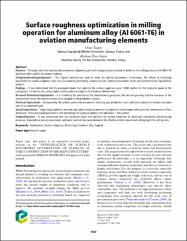Surface roughness optimization in milling operation for aluminum alloy (Al 6061-T6) in aviation manufacturing elements
Citation
Seçgin, Ö., & Sogut, M. Z. (2021). Surface roughness optimization in milling operation for aluminum alloy (Al 6061-T6) in aviation manufacturing elements. Aircraft Engineering and Aerospace Technology, 93(8), p. 1367-1374.Abstract
Purpose: This paper aims that optimization parameters depending on machining processes examine to define for the milling process of AL 6061-T6 aluminum alloy used in the aviation industry. Design/methodology/approach: The Taguchi method was used to study the optimal parameters. Furthermore, the effects of machining parameters on surface roughness were also evaluated by performing variance analysis. Optimum parameter levels were determined by Signal/Noise analysis. Findings: It was determined that the parameter levels that optimize the surface roughness were “4000 rev/min for the rotational speed of the cutting tool, 0.4 mm for the cutting depth and the optimum value for the feedrate 500 mm/min.” Research limitations/implications: It is limited by the precision of the manufacturing processes, the desired geometry and the exactness of the measurement make the machine productivity valuable in the production of parts. Practical implications: By improving the optimal production parameters, reducing part production costs and waste amount in aviation has been seen as an important gain. Social implications: Improving production methods and optimization parameters in production technologies will ensure the minimization of loss and waste. These developed parameters with optimizing the surface roughness will add value in this context. Originality/value: It was determined that the parameter levels that optimize the surface roughness of aluminum considering manufacturing processes. Especially as process parameters, optimum feed rate has been developed for effective rotation speed and cutting depth for cutting tools.

















